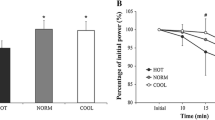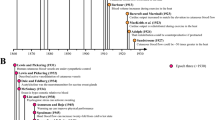Summary
Evolution of rectal temperature (T re ) during recovery in different air temperatures was studied following different patterns of heat load before and after adaptation to work in heat (10 consecutive days). Three subjects have been exposed, after a 30 min rest period (T a = 28‡ C, P wa = 14 mb) to 4 heat loads, each producing 1‡ C increase in T re in approximatively 30 min (C 0∶T a = 50‡ C, P wa = 60 mb, W = 0 watt; C 1: 50‡ C, 42 mb, 50 W on bicycle ergometer; C 2: 39‡ C, 38 mb, 100 W and C 3: 28‡ C, 31 mb, 150 W). After each of these heat loads, subjects were allowed to recover during 2 h at T a = 28, 22 or 16‡ C (P wa = 14 mb).
Results show that: (a) the cooler was the T a , the faster was the recovery time; (b) before adaptation occurs, the evolution of T re depended on the preceding heat load pattern; (c) the more intense was the work load, the more the adaptation reduced time for subsequent recovery.
The interaction obtained between adaptation and intensity of preceding work load is discussed. The evolutions of leg skin temperatures suggest that a decreased local heat conductance (of inferior limbs) is associated with a local increase in external heat exchange. Adaptation to work in heat would take the form of a local re-adjustment of internal and external heat exchanges.
Résumé
Nous avons suivi l'évolution de la température rectale (T re ) au cours de la récupération consécutive à diverses charges thermiques (exogène, endogène ou mixte) avant et après une adaptation aux conditions expérimentales (10 jours consécutifs d'exposition à la condition C 1). Trois sujets ont subi après un repos de 30 min (T a = 28‡ C, P wa = 14 mb), 4 charges thermiques entraÎnant une élévation de T re de 1‡ C en 30 min environ (C 0∶T a = 50‡ C, P wa = 60 mb, W = 0 Watt; C 1: 50‡ C, 42 mb, 50 W; C 2: 39‡ C, 38 mb, 100 W et C 3: 28‡ C, 31 mb, 150 W). Indépendamment de la charge thermique subie, ils ont ensuite récupéré pendant 2 h, soit à 28, 22 ou 16‡ C de T a (P wa = 14 mb).
Les résultats montrent que: (a) la récupération est toujours plus rapide si la température d'air est plus fraÎche: (b) l'évolution de la température rectale est avant adaptation influencée par le type de contrainte thermique subie préalablement: (c) l'adaptation réduit d'autant plus la durée de récupération que la charge endogène antérieure a été plus intense.
Les résultats concernant le point (c) sont discutés. L'évolution des températures cutanées des membres inférieurs suggère une diminution de la conductance thermique locale (au niveau des membres inférieurs) associée à une augmentation locale du transport externe de chaleur. L'adaptation à l'exercice en ambiance chaude se traduirait par un double réajustement local des transports interne et externe de chaleur.
Similar content being viewed by others
Bibliographie
Bass, D. E.: Thermoregulatory and circulatory adjustments during acclimatization to heat in man. In: Temperature: Its measurements and control in science and industry, Vol. 3 (J. D. Hardy, ed.). New York: Reinhold 1963
Bazett, H. C., Love, L., Newton, M., Eisenberg, L., Day, R., Forster, R.: Temperature changes in blood flowing in arteries and veins in man.. J. appl. Physiol. 1, 3–19 (1948)
Elsner, R. W., Carlson, L. D.: Post exercice hyperemia in trained and untrained subjects. J. appl. Physiol. 17, 436–440 (1962)
Gisolfi, C. V.: Work-heat tolerance derived from interval training. J. Appl. Physiol. 35, 349–354 (1973)
Hardy, J. D., Dubois, E. F.: Basal metabolism, radiation, convection and evaporation at temperatures of 22–35. J. Nutr. 15, 477–496 (1938)
Hofler, W.: Changes in regional distribution of sweating during acclimatization to heat. J. appl. Physiol. 25, 503–506 (1968)
Kollias, J., Boileau, R., Buskirk, E. R.: Effects of physical conditioning in man on thermal responses to cold air. Int. J. Biometeor. 16, 389–402 (1972)
Mead, J., Bonmarito, C. L.: Reliability of rectal temperatures as index of internal body temperature. J. appl. Physiol. 2, 97–115 (1949)
Minard, D., Copman, L.: Elevation of body temperature in health. In: Temperature: Its measurements and control in science and industry, Vol. 3. (J. D. Hardy, ed.). New York: Reinhold 1963
Nielsen, B., Nielsen, M.: Body temperature during work at different environmental temperatures. Acta physiol. scand. 56, 120–129 (1962)
Piwonka, R. W., Robinson, S., Gay, V. L., Manalis, R. S.: Preacclimatization of men to heat by training. J. appl. Physiol. 20, 379–384 (1965)
Piwonka, R. W., Robinson, S.: Acclimatization of highly trained men to work in severe heat. J. appl. Physiol. 22, 9–11 (1953)
Randall, W. C., Hertzmann, A. B.: Dermatomal recruitment of sweating. J. appl. Physiol. 5, 399–409 (1953)
Scott, J. C., Bazett, H. C., Mackie, G. C.: Climatic effects on cardiac output and the circulation in man. Amer. J. Physiol. 129, 102–122 (1940)
Wells, C. L., Buskirk, E. R.: Limb sweating rates overlying active and non active muscle tissue. J. appl. Physiol. 31, 858–863 (1971)
Wenzel, H. G.: Die Erholungsdauer nach Hitzearbeit als Ma\ der Belastung. Forschungsberichte des Landes Nordrhein-Westfalen, No. 1544, 1 Vol. 79 pp. Cologne: Westdeutscher Verlag 1965
Wyndham, C. H.: Effect of acclimatization on circulatory responses to high environmental temperatures. J. appl. Physiol. 4, 383–395 (1951)
Wyndham, C. H., Strydom, N. B., Cooke, H. M., Maritz, J. S., Morrison, J. F., Fleming, P. W., Ward, J. S.: Methods of cooling subjects with hyperpyrexia. J. appl. Physiol. 14, 771–776 (1959)
Author information
Authors and Affiliations
Rights and permissions
About this article
Cite this article
Candas, V., Vogt, J.J., Hoeft, A. et al. Influence de l'adaptation au travail à la chaleur sur l'évolution de la température rectale au cours de la récupération. Europ. J. Appl. Physiol. 36, 193–205 (1977). https://doi.org/10.1007/BF00421750
Received:
Issue Date:
DOI: https://doi.org/10.1007/BF00421750




